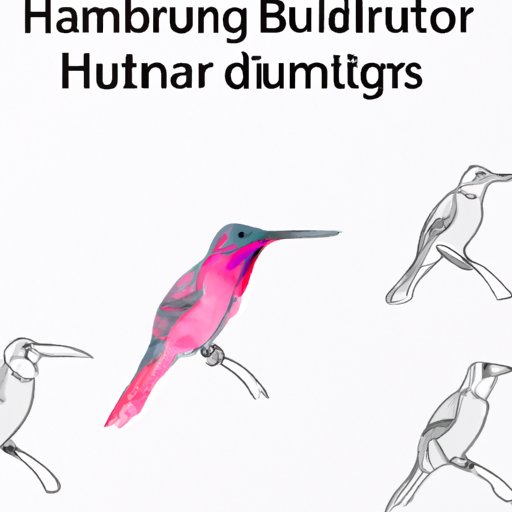
Introduction
Drawing hummingbirds can be an exciting and rewarding experience for artists of all levels. However, capturing the unique and delicate features of these birds may be challenging for some. With this tutorial, beginners and experienced artists alike can learn how to draw a hummingbird with confidence and precision. Before diving into the step-by-step instructions, let’s explore some interesting facts about these birds.
Did you know that hummingbirds are the smallest bird species in the world? They’re also the only birds that can fly forwards, backward, and even upside down. Their wings can beat up to 80 times per second, allowing them to stay suspended in the air while drinking nectar from flowers. Hummingbirds are also remarkable for their vibrant coloring and iridescence, meaning they can change their colors depending on the angle of light. With these unique traits, hummingbirds make an excellent subject for any art piece.
Step-by-Step Tutorial
To begin drawing a hummingbird, start by sketching the basic outline of the bird’s body using a light pencil. Focus on the bird’s head, long beak, and body shape. Next, outline the bird’s wings, ensuring that they’re proportionate with the bird’s body. Once you’re satisfied with the outline, you can start adding more details to the drawing. Start with the bird’s head, adding an eye, nostril, and other facial features. Next, add more details to the beak and elongated body. Use a darker pencil to make the outlines more prominent.
Coloring Your Hummingbird
Once you’re satisfied with the outlines, it’s time to add some color. Depending on your preference, you can use colored pencils, watercolors, or any other color medium. When coloring your hummingbird, start with the base color of the bird’s body, typically green but can also be a mix of blues and purples depending on the species. Once the base color dries up, you can add more details such as the bird’s iridescence features, patterns and markings. You might also consider adding shadows and highlights to create depth and dimensionality in your drawing.
Adding Final Touches
At this point, you should have a rough idea of where your drawing is headed. Take a step back and evaluate your work. Is there anything you’re missing? Are the proportions correct? If you find that you need to make some changes, this is the stage where you can go ahead and tweak your work. When you’re satisfied with your work, add some final touches and details to enhance the hummingbird’s beauty.
Video Tutorial
If you prefer visual instructions, you can also follow a video tutorial on how to draw a hummingbird. YouTube offers several options, depending on the artist’s take on the subject and personal style. Some tutorials are sped up with music, while others offer a step-by-step guide with voiceover or captions.
Tips and Tricks
Improving your hummingbird drawing skills is more comfortable with some simple tips and tricks. Here are some essential tips that you can incorporate into your drawing process:
Focus on Proportions
To create a realistic hummingbird drawing, you need to focus on proportions. Pay attention to the bird’s wings, beak, head, and body shape. Hummingbirds have a unique body shape, which is long and narrow, so make sure you get that right.
Shading and Texturing
Shading and texturing are essential techniques that you need to master to create a realistic hummingbird drawing. Use lighter strokes for the base color and gradually build up the color intensity layer by layer. Use cross-hatching and stippling techniques to add texture and depth to the bird’s feathers and body.
Experiment with Colors
Hummingbirds have an array of vibrant colors that they exhibit in different orientations. Don’t be afraid to experiment with different color combinations to achieve an iridescent appearance. You can use different shades of greens, blues, purples, and pinks to create a beautiful and realistic hummingbird.
Hummingbird Anatomy
To draw a hummingbird accurately, you need to understand the anatomy of a hummingbird. Hummingbirds have unique physical features, including their long beak, wings, and feet. Here’s a breakdown of a hummingbird’s anatomy:
Head
A hummingbird’s head is small and rounded. It has two eyes located on the sides of the head, a long beak, and a tongue. The beak is long and thin and curves downwards, giving the bird its unique shape.
Wings
Hummingbirds’ wings are long and narrow and are specialized for hovering in mid-air. They have specialized feathers that allow the wings to twist and turn while beating up to 80 times per second, making them one of the fastest birds in the world.
Body
Hummingbirds have a unique body shape that’s elongated and thin. Their body is covered with iridescent feathers that shimmer and change, depending on the angle of light.
Feet
Hummingbirds have small feet, which are not well-suited to walking but are perfect for perching on branches and flowers.
Fun Facts
In addition to their unique physical characteristics, hummingbirds have fascinating habits. Here are some fun facts about hummingbirds:
– Hummingbirds can fly up to 60 miles per hour, making them one of the fastest birds in the world.
– Hummingbirds can see colors that humans can’t, including ultraviolet and infrared colors.
– Hummingbirds can remember every flower they’ve visited and how long it will take the flowers to refill with nectar.
– Hummingbirds can consume up to two times their body weight in nectar every day.
– Some species of hummingbirds migrate from North America to Central America and back each year.
Conclusion
Drawing a hummingbird is a fun and rewarding experience for artists of all levels. With this step-by-step tutorial, video tutorial, and essential tips and tricks, you can create a stunning hummingbird drawing that accurately captures the bird’s unique physical features. Don’t forget to practice and experiment with different color combinations to enhance the bird’s iridescent appearance. Have fun and keep honing your hummingbird drawing skills.





